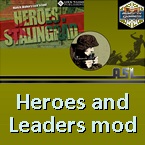asl3d
Posts: 6531
Joined: 2/6/2017
Status: offline

|
The PzJg III/IV, Rhino or Nashorn, also known as the Hornisse (Hornet), consisted of a composite PzKpfw III/IV chassis carrying the 8.8cm PaK 43/1.
After the first encounters with tanks like the T-34 and the KV-1 in the summer of 1941, the OKH was well aware that it had to quickly devise a response, in order to have the necessary firepower when needed. Older tank hunters equipped with the Pak 40 75 mm gun, like the Marder, were barely sufficient against the KV-1, so the adoption of the most efficient piece in the German ordnance came as a necessity. Following the specifications of 1942, a tank hunter was planned to carry the ubiquitous 88 mm gun
Alkett choose the Geschützwagen III/IV chassis to mount the heavy 8,8 cm Panzerabwehrkanone 43/1 L/71 (Pak 43/1), a lightweight version of the standard German AA gun, also mounted on the Tiger II tank. The chassis was based on the Panzer IV, with the same suspension configuration with four bogies, each with two pairs of rubberized road wheels, idlers at the rear and drive sprockets at the front, but lengthened and strengthened. The hull armor was 30 mm at the front, 20 mm on the sides and 15 mm for the rear plate. The engine was a Maybach HL 120 TRM Ausf.A V12 producing 300 hp@3000 rpm, with 11,867 L of displacement. There was no secondary armament except one 7.92 mm MG 34 or MG 42 machine-gun carried inside the vehicle, with 600 rounds in store. The gun was aimed by a gunner’s sight with a 5x magnification, 8° field of view, and had an indirect fire sight Aushilfsrichtmittel 38 with a 3x magnification, 10° field of view. There was also a FuG Spr.f radio. In addition, the Panzergranate 40/43 tungsten carbide–cored round could defeat 190 mm of RHA at a 30° angle at 1,000 m. This allowed the Hornisse to engage enemy units while staying out of range themselves. So there was no need for armor protection.
The production began in January 1943 as the 8,8 cm Pak 43 (L/71) auf Fahrgestell Panzerkampfwagen III/IV (Sf) or 8,8cm Pak 43 (L/71) auf Geschützwagen III/IV (Sd.Kfz.164). The bulk of the 494 vehicles produced were delivered in 1943 (345), however the remainder were delivered discontinuously, 133 from February to November 1944, and only 16 from January to March 1945.
When entering service, the Hornisse was issued to six of the newly-formed heavy antitank battalions, the schwere Panzerjäger Abteilungen 560, 655, 525, 93, 519 and 88, each with 45 vehicles. The main gun was derived from the regular 88 mm (3.46 in) Pak 43, one of the most effective anti-tank guns of the war, and later used, with few modifications, on the Ferdinand/Elefant, Tiger II and Jagdpanther. This made the Nashorn the first of the German alpha predator bred for the Eastern Front. The Sd.Kfz.164 was first blooded at the Battle of Kursk, and performed quite well, engaging heavies like the KV-1. Its long-range ability was found particularly adapted to the open and flat landscapes of Russia. Added to this, the open fighting compartment gave excellent peripheral vision compared to an enclosed turret. After Kursk, three of these Abteilungen, the 560 sPzJagAbt, 655th sPzJagAbt and 525 sPzJagAbt, were sent to Italy. They again proved to be successful tank destroyers. Six more schwere Panzerjager Abteilungens (560, 655, 525, 93, 519 and 88), each equipped counting 30 Nashorns, saw service on the Eastern Front, Normandy and Italy. Each Abteilung was composed of a command company and 2-3 companies (14-17 tank hunters each) with 4 platoons each. A Nashorn from the 2nd Company, Abteilung 93 destroyed the only M26 Pershing in Europe, at 250 meters, with the first shot, in Niehl, north of Cologne, March 6, 1945.

 Attachment (1) Attachment (1)
_____________________________
Semper fidelis
|
 Printable Version
Printable Version





































 New Messages
New Messages No New Messages
No New Messages Hot Topic w/ New Messages
Hot Topic w/ New Messages Hot Topic w/o New Messages
Hot Topic w/o New Messages Locked w/ New Messages
Locked w/ New Messages Locked w/o New Messages
Locked w/o New Messages Post New Thread
Post New Thread